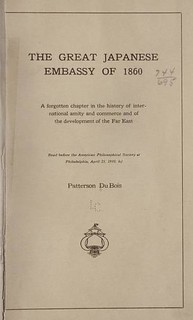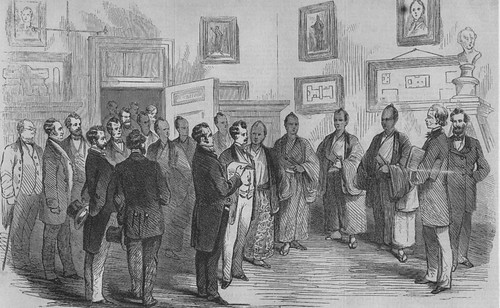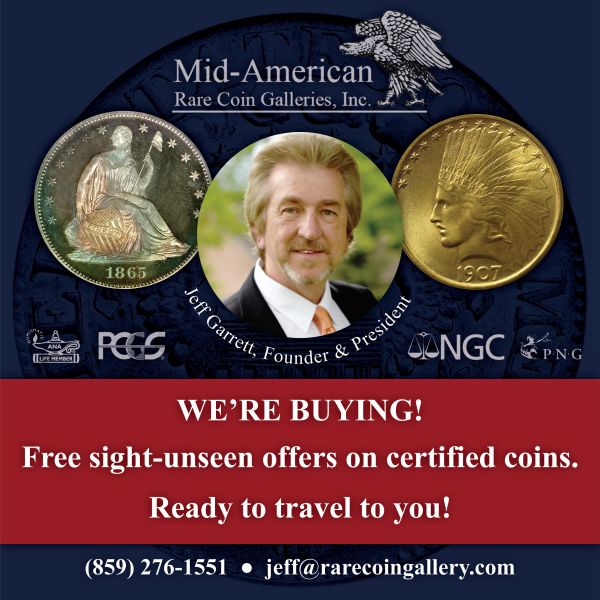
PREV ARTICLE
NEXT ARTICLE
FULL ISSUE
PREV FULL ISSUE
1860 JAPANESE VISIT TO U.S. MINTThe Defense Visual Information Distribution Service published an article on the Japanese envoy's first visit to the U.S. Mint in 1860. Interesting event! -Editor Visit of the Japanese to the Philadelphia Mint, June 13th, 1860. A 19th century illustration from Frank Leslie's Illustrated Newspaper. In 1860 Japan's Shogunate officially sent 80 samurais to the United States to establish a diplomatic and economic relationship with the White House. Their primary mission was to ratify the Treaty of Amity and Commerce Between the United States and Japan. Signed in 1858, the treaty enabled Japan to trade further with more foreign countries, which the government had long restricted to the Netherlands and China for nearly 250 years. The 1858 treaty made Japan incorporate into international relationships both politically and economically. The Japanese envoy had another mission in the U.S.; to survey the Mint and American monetary system. They stopped at the U.S. Mint in Philadelphia after the ratification exchange in Washington D.C., before they visited New York. Japan had been troubled by an outflow of gold since Japan had agreed upon the Kanagawa Treaty six years earlier, in 1854. This treaty initiated an economic and mutually beneficial relationship with the U.S., allowing Americans to reside on Japanese soil and engage in economic activities temporarily. Another problem was the money Japan had circulated in its market. The monetary system was based on three kinds of coins — gold, silver, and copper. Each type of coin had a different method of denomination, which made things more complicated, mainly when they traded with other countries. Under an agreement with the U.S General Consul Townsend Harris in 1858, Japan had consented to a 1-dollar silver coin (Mexican silver, which was used for domestic and international money at trades), which equaled three 1-bu Japanese silver coins in exchange, with which Japan was not satisfied. That was because Japan's monetary system was based on three separate trimetallic systems: gold, silver, and copper. In measuring a 20-dollar U.S. gold coin, for example, against the value of Japanese silver bu-coins, one dollar nearly came to the value of one bu silver coin. Harris insisted that foreign currency be circulated in Japan, but Japan was hesitant about having foreign money in its market. Consequently, with a compromise, the two parties concluded that the exchange rate of one Mexican silver coin be three Japanese bu silver coins, based on the condition that the exact weight equals the same value.
Put another way, according to a research paper titled Using this system, one could cash in on the Japanese monetary exchange system by moving Mexican coins through Japan, allowing foreigners to increase their money's value quickly, and moving Japanese gold out of the country and into the world.
One of the most insightful Japanese envoys was Kozukenosuke Oguri, who acted as an inspector/censor and overseer of Japan's diplomacy. At the Mint in Philadelphia, he demanded clarification regarding the amount of gold and silver used in both Japanese and American coins at the Mint to determine the
One American, an author and educator, Patterson Du Bois depicted the event in a book,
Later Oguri and his men thanked the officers of the Mint for their courteous attention, Patterson Du Bois was an assistant assayer at the Mint and son of 48-year Mint stalwart William DuBois. His 40-page monograph includes about eight pages of text on the Mint visit (p252-260), for which he was physically present. -Editor 
"Preliminary formalities being over the occasion was so extraordinary that a messenger was quietly despatched with orders to go to a nearby grammar school and procure a release for the day of three pupils, sons of the assayer and his assistant, bring them to the laboratory where their education might take a rare turn in a leisurely and close contact with the ambassadors and their attendants. I was the youngest of those three boys, and I am now drawing on memory which is both stimulated and held in leash by certain mementos, personal notes of the assistant assayer, various public prints and official documentary memoranda.
"Entering the little
To read the complete article, see:
To read the complete paper on the Newman Portal, see:
Wayne Homren, Editor The Numismatic Bibliomania Society is a non-profit organization promoting numismatic literature. See our web site at coinbooks.org. To submit items for publication in The E-Sylum, write to the Editor at this address: whomren@gmail.com To subscribe go to: https://my.binhost.com/lists/listinfo/esylum All Rights Reserved. NBS Home Page Contact the NBS webmaster 
|

